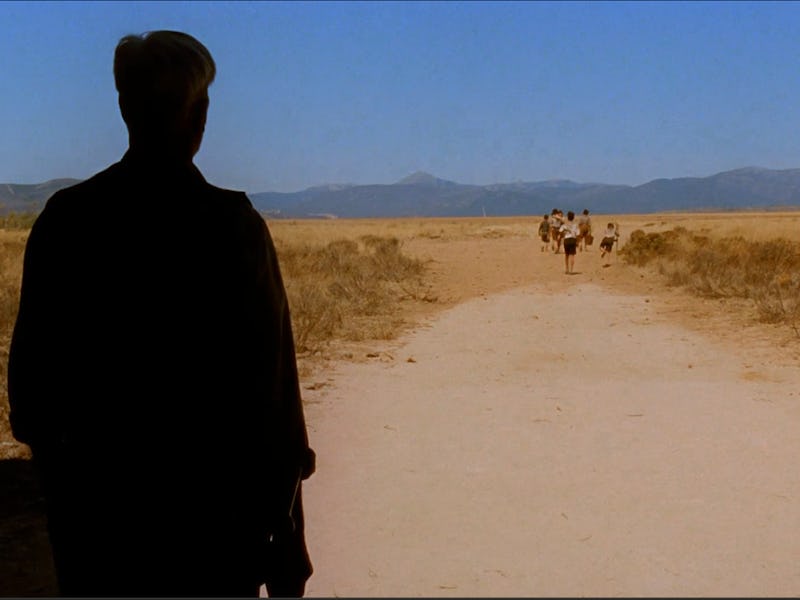You need to watch the most revolutionary ghost story on HBO Max ASAP
“What is a ghost? A tragedy condemned to repeat itself time and again?”

2022 is the year of Guillermo del Toro.
The “atmospheric horror” auteur has directed, produced, and written a long list of highly-acclaimed movies and TV shows, garnering him a faithful fanbase over the past three decades. These include Cronos (1993), Blade II (2002), Hellboy (2004), Pacific Rim (2013), FX’s The Strain (2014-2017), and Nightmare Alley (2021), among many others.
This year, he’s gifting aficionados with two Netflix specials: Cabinet of Curiosities, an eight-episode horror anthology series curated by del Toro that’s out now, and Pinocchio, a stop-motion project due in December.
Del Toro has called Pinocchio the third entry in his unofficial anti-fascism fairytale trilogy. The Devil’s Backbone and Pan’s Labyrinth take place during the Spanish Civil War and its Francoist aftermath, while Pinocchio is set in Benito Mussolini’s Italy.
The Devil’s Backbone, a low-budget, Spanish-language indie, is one of del Toro’s lesser-known entries, but fans of Pan’s Labyrinth will undoubtedly be entranced by it. “They are ‘mirrored movies,’ which reveal symmetries and reflections if you ever watch them together... and I love them both with equal passion,” del Toro said in a 2017 retrospective for Entertainment Weekly.
Before Pinocchio’s BFI London Film Festival premiere, del Toro mused that all three films are about childhood and fatherhood colliding with war and violence. “Fascism seems to be concerned with a father figure of a different kind and the desire to deliver ourselves to a father that unifies thought. So I think it’s both a background and it is something interesting thematically.”
In the case of The Devil’s Backbone, directed and co-written by del Toro and released in 2001, fathers and brothers are gained and lost in this gut-wrenching ghost story set in a grim orphanage in Middle-of-Nowhere, Spain. Guillermo del Toro's signature cinematographic panache and penchant for political gothic horror make The Devil's Backbone a terrifying delight.
The doctor of the orphanage, Dr. Casares (Federico Luppi), keeps a collection of preserved infants dead from spina bifida in spiced rum.
Toward the end of the Spanish Civil War, the young son of an upper-class Republican loyalist, Carlos (Fernando Tielve), becomes an orphan. Two loyalists take Carlos to a decrepit, makeshift orphanage in the harsh desert run by Carmen (Marisa Paredes) and Dr. Casares (Federico Luppi), who can barely manage the wards they already have. All the residents are children whose parents are either fighting for the Republican cause, or have died trying.
The orphanage also doubles as a Republican treasury, and it’s an open secret that a hoard of gold ingots have been stashed there. Thus, the orphanage is a frequent target of Franco’s troops. A deactivated bomb sits in the middle of the courtyard where the boys play, constantly reminding them of the horrors of war and a mysterious tragedy that occurred the same night the bomb dropped: One of their peers disappeared.
DDT Studios in Barcelona created Santi’s ghost, his face resembling cracked porcelain to denote innocence lost.
Carlos thinks he sees the missing child. And he thinks he hears him whispering, “Many of you will die” in the night. While the orphanage bullies Jaime, Gálvez, and Owl give Carlos crap for being “posh” and believing in phantoms, they soon realize he might be onto something.
Meanwhile, Dr. Casares and Carmen are trying to figure out what they’re going to do with these boys once the Republicans lose. Former orphanage resident and current groundskeeper Jacinto (Eduardo Noriega), and his fiancée Conchita (Irene Visedo), are also loyalists who know Franco’s victory is inevitable. Their master plan for their future together? Robbing the Republicans.
But everyone’s plans hit a wall when the specter’s origins — and his killer — are revealed, prompting allegiances both supernatural and mundane to be made in the pursuit of justice and revenge.
Dr. Casares, Carlos, and Jaime.
The Devil’s Backbone was received well, and has spent the past two decades acquiring more acclaim. Even Taylor Swift couldn’t help but be charmed, citing it and del Toro’s other political fantasy films as some of her biggest inspirations. “I remember watching two Guillermo del Toro movies back to back — The Devil's Backbone and Pan's Labyrinth — and my whole world became fairy tales,” she said at a Toronto Film Festival panel in 2022.
If Taylor’s word isn’t enough, The New York Times noted that The Devil’s Backbone “balances dread with tenderness,” and Bloody Disgusting dubbed it “alternately a gut-wrenching portrait of childhood in a time of war and a skin-crawling, evocative nightmare.” It did not, however, fare particularly well at the box office.
The Devil’s Backbone was filmed on the outskirts of Madrid.
“I’d rather communicate the right story to a lesser number of people than the wrong story to a larger number of people,” del Toro said in a 2001 interview with IndieWire. “I bust my ass for the movies I do to, at least, look really good. I try to make them gorgeous and I try to make them look big, within their budget.”
And that it did. Along with a heart-rending narrative that seamlessly blends hauntings and anti-fascist propaganda, The Devil’s Backbone is rife with awe-inspiring Spanish landscapes, sharp period piece costuming, and meticulous set design to elicit all the feels (and spooks).
“A film about ghosts cleared all ghosts from my past. A film about loss gave me life again. A story of orphans gave me a filmmaking family,” del Toro wrote in a 2017 retrospective. “Disguised as a Gothic tale, The Devil’s Backbone hides a beating heart and a story about loss and the phantoms of regret. It is a worthy ‘boy’s adventure’ and a small fable full of melancholy. This film is full of love and worthy of love. I do hope you’ll agree.”
The Devil’s Backbone is streaming on HBO Max.
This article was originally published on